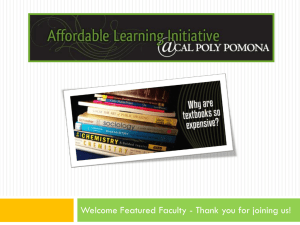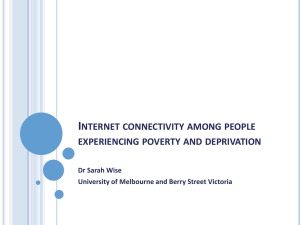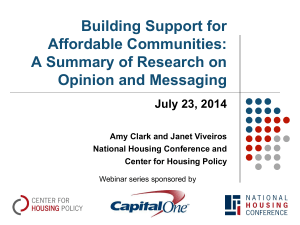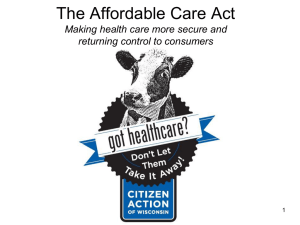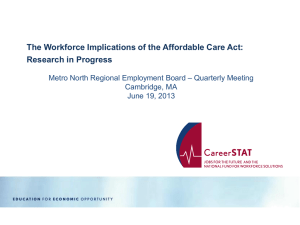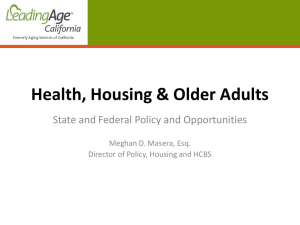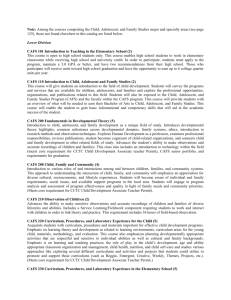AH101-20131 - The Alliance For Housing Solutions
advertisement
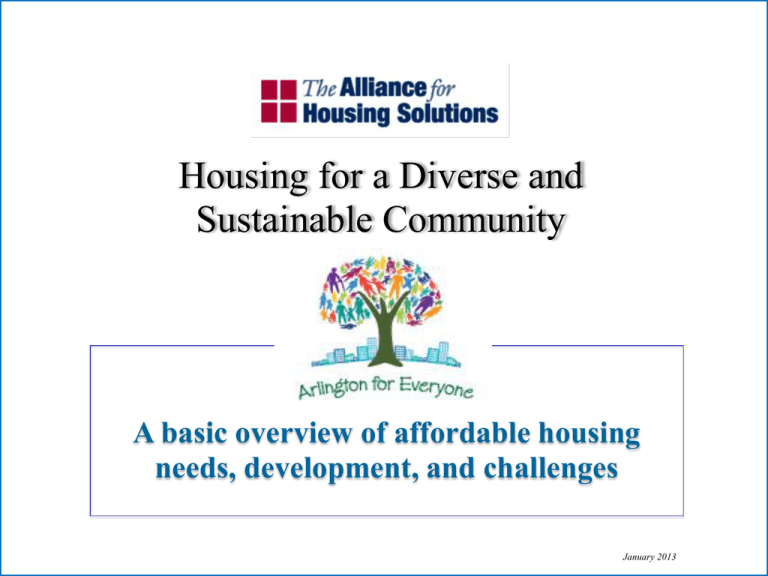
Housing for a Diverse and Sustainable Community A basic overview of affordable housing needs, development, and challenges January 2013 Before we get started . . . Note that Arlington County • does not have a public housing authority • but provides assistance with housing in a variety of ways, including direct grants to lower income families, seniors, and persons with disabilities. This presentation focuses on preservation and creation of affordable housing units, especially units called “committed affordable” (or CAFs) 2 “Affordable” housing comes in all property types • • • • • Single family and multifamily Garden apartments and highrises Rental [mostly] and home ownership New construction and existing buildings “Mixed income” complexes 3 Affordable housing defined by the Department of Housing and Urban Development— Decent, quality housing that costs no more than 30 percent of a household’s gross monthly income for rent/mortgage and utility payments 4 Who needs affordable housing? • A variety of workers vital to our community’s health, safety, and economic success, including: • Teachers, first responders, and health-care workers • Retail, hospitality, and service workers • Young people—many of whom were raised in Arlington—launching careers and families • Persons on fixed incomes, such as seniors and persons with disabilities 5 Why affordable housing matters An adequate supply of affordable housing helps the entire community by— • Supporting and sustaining economic development, helping employers attract and retain workers and keeping the Arlington economy resilient • Keeping Arlington diverse—economically, culturally, and age-wise 6 Why affordable housing matters, cont. • Reducing commuting, yielding a cleaner environment, reducing stress and improving wellness • Reducing turnover in schools, which is good for students, families, and Arlington schools • Creating a “sense of place” (community) and reducing family displacement 7 Affordable units—the link to median income levels Area Median Income (AMI): The middle income in a given area. Of households in the area, half earn less than the median; half earn more. Other key facts: • Calculated by HUD based on household size • Determines eligibility for various housing programs • Affordable unit set-asides are pegged to various levels of AMI 2012 Median Income for Washington DC Metro Area For a family of 4 $107,500 For a 1-person household $75,300 8 Two types of affordable units “Market-rate affordable” housing units (MARKs) Privately-owned units with “market” rents affordable to households up to 80% of AMI No requirement that they stay affordable Often described by affordability level— 80% MARKs—units affordable at 61-80% 60% MARKs—units affordable at/below 60% “Committed affordable” units (CAFs) Units with income-restricted rents for an extended period, generally for households at 60% AMI and below 9 Affordability by household size At 60% of AMI—the target for most CAFs SIZE INCOME/yr INCOME/mo “AFFORDABLE” (at 30%) 1 person 45,180 3,765 1,130 2 person 51,600 4,300 1,290 64,500 5,375 1,612 4 person 2011 Average Rents Efficiency One-Bedroom Two Three $1,337 $1,615 $2,063 $2,421 10 Housing pressure in Arlington • In Arlington, 2 in 5 rental households pay 30% or more for rent • A wage of $33.63/hour (assuming 160/hr month) would be required for an average one-bedroom to be affordable 11 Creating CAFS • CAFs can be created by renovation or new construction, usually by a nonprofit developer. • Creating a CAF requires creativity and cooperation to put together the financial pieces. • The County is often needed to help close the “gap” between the cost to renovate/build and operate the CAF unit and what the assisted AMI% level household can afford. 12 Creating CAFs: The big-ticket item Land Cost $6 million Per Unit: 50 units $120,000 Per Unit: 100 units $60,000 Land cost is not the only challenge, but density matters… 13 The CAF package To cover costs, a typical CAF package includes: • A commercial mortgage(s) • Tax credits and/or bonds—most awarded by the State on a competitive basis • A County gap “contribution”—such as a loan from the Affordable Housing Investment Fund (AHIF), “bonus density”, or land • A developer contribution—the developer defers fees and/or puts equity into the deal 14 County gap financing sources • Affordable Housing Investment Fund (AHIF) loans from a revolving fund financed through general revenue, developer contributions (in lieu of providing affordable housing units), and AHIF loan repayments • Project-specific Industrial Development Bonds by the County. Revenue from the development pays for the bond. • Grants, often federal pass-through money, for housingrelated services 15 Other Country resources to support CAFs Bonus density permits additional market-rate and CAF units, with the income from the market-rate units designed to offset the cost of the CAFs Transfer of development rights (TDR) allows a site to send density and other development rights for the purposes of the preservation/facilitation of affordable housing (or other community benefits: open space, historic preservation, etc.) Public land donation. Arlington Mill is one example. County-provided infrastructure such as streetscapes, sidewalks, utility grounding, etc., to help keep costs down 16 Parc Rosslyn Developed by Arlington Partnership for Affordable Housing (APAH) • Redevelopment of 22 market-affordable garden apartments • “Mixed”:142 market rate and 96 CAF • VHDA bond, AHIF, LIHTC, TDR, APAH equity • Won major design award, 2009 17 The Jordan Developed by AHC, Inc. • Redevelopment of 24 market-affordable garden apartments • 90 CAFs walking distance from Ballston Metro • Site acquired through land swap with commercial developer • AHIF, LIHTC, AHC equity 18 vPoint of Clarendon Developed by The Views at Clarendon Corporation • “Mixed”: 46 marketrate and 70 CAFs • Preservation of landmark steeple and onsite daycare and other benefits • Additional density, AHIF 19 The Gates (Ballston) Renovation by AHC, Inc. Before— After— 464 affordable apartments, a new community center, and . . . 20 . . . winner of the 2009 Historic Preservation Award from the National Trust for Historic Preservation 21 Buchanan Gardens (South Buchanan Street) Renovation by APAH includes expanded family units and this new playground 22 CAFs are regulated and provide community benefits • Yearly income certification • Overcrowding forbidden • County architectural, building, and streetscape standards • Ongoing business relationship with the County and State agencies encourage good practices • Onsite family- and school-oriented services provided 23 Affordable housing challenges in Arlington • Land (the lack of it plus high price) and our high Area Median Income • Many MARKs have been and are being renovated into upscale units • From 2003-2011, the County has averaged 293 net new CAFs per year, but demand for CAF units far outweighs supply • Arlington needs more affordable units for its current and projected future workforce 24 2011 rental unit breakdown 3,035 – 8% 4,307 – 11% 4,685 – 12% Market rate 8,500 – 23% units > 80% 17,500 – 46% 22(48%) 3,570 – 8% CAFs Rental CAFs (14%) 40-60% Marks MARKs up to 60% (12%) 6,685 – 15% 60-80% MARKS 15,442 – 36% Market Rate (>80%) MARKs at 60-80% (25%) 11,429 – 27% Pg 34, Goals and Targets Report. Source: Arlington County CPHD 25 Loss of 50% and 60% MARKs 20000 18000 UP to 60 % of AMI 16000 Up to 50% of AMI 14000 12000 10000 8000 6000 4000 <$1250, 46% <$1250, 54% $1750-2249, 14% $1250-1749, 35% $1750-2249, 11% $2250+, 9% 2000 0 2000 2001 2002 2003 2004 2005 2006 2007 2008 2009 2010 2011 Pg 35, Goals and Targets Report. Source: Arlington County CPHD 26 Jobs v. housing: Short- and long-term gaps In October 2011, George Mason’s Center for Regional Analysis released a major study warning that the region’s economic engine could stall: • Local jurisdictions are planning for an insufficient amount of housing to accommodate future workers. • There is a need for more multi-family housing and smaller, more affordable owner and renter homes in the region. ~ Housing the Region’s Future Workforce: Policy Challenges for Local Jurisdictions Arlington County acknowledges a more immediate need: “Based on the regional ratio of needing one housing unit for every 1.6 new jobs, 3,000 new affordable units would need to be added in Arlington between 2010 and 2015 to serve new workers” ~ Arlington County Annual Affordable Housing Targets Report for 2011 27 What’s on the horizon? Columbia Pike Neighborhoods Plan Adopted by County Board July 2012; implementing plans began late 2012. Creating and preserving affordable units are among the key goals. More than half of Arlington’s remaining MARKs are along the Pike corridor. Goal: Preserve all 6,200 MARKs over the next 30 years. Tools to achieve preservation: • AHIF • New form-based code (FBC), includes increased density • Transfer of Development Rights 28 • Other tools What’s on the horizon? Arlington Housing Study A multi-year plan to assess community housing needs, establish long-term objectives, and develop strategic directions. A housing needs survey will provide valuable data for the study—the last such survey was done 10 years ago. County Board adopted charge December 2012. First meeting of citizen working group expected February 2013. 29 Questions for our community Can we convert an adequate number of MARKs to CAFs? Will lack of housing choices stall economic growth? Where will Gen Y live? Will Arlingtonians work together to ensure our County vision of a “diverse . . . and sustainable community in which each person is important”? 30 “What can I do?” • Stay informed! Visit the AHS website and sign up for updates. • Share this information. Talk to your friends and neighbors about the challenges we face and the importance of our housing mix. • Consider volunteering with nonprofit providers to help provide onsite student and family support services and/or maintenance assistance. 31 Recap How “affordable housing” is defined Who needs affordable housing Why it is important to any community and to Arlington in particular How it is developed and what “committed” affordable housing looks like What challenges Arlington faces in providing committed affordable housing What you can do 32 Thank you! For more information, including sourcing and list-serve sign up— www.AllianceforHousingSolutions.org For more on Arlington County housing assistance services— http://bit.ly/Kry4dL To learn about nonprofit providers serving Arlington— AHCInc.org—AHC, Inc. APAH.org—Arlington Partnership for Affordable Housing WesleyHousing.org—Wesley Housing Development Corp RPJhousing.org—RPJ Housing CPDC.org—Community Preservation and Development Corporation 33

